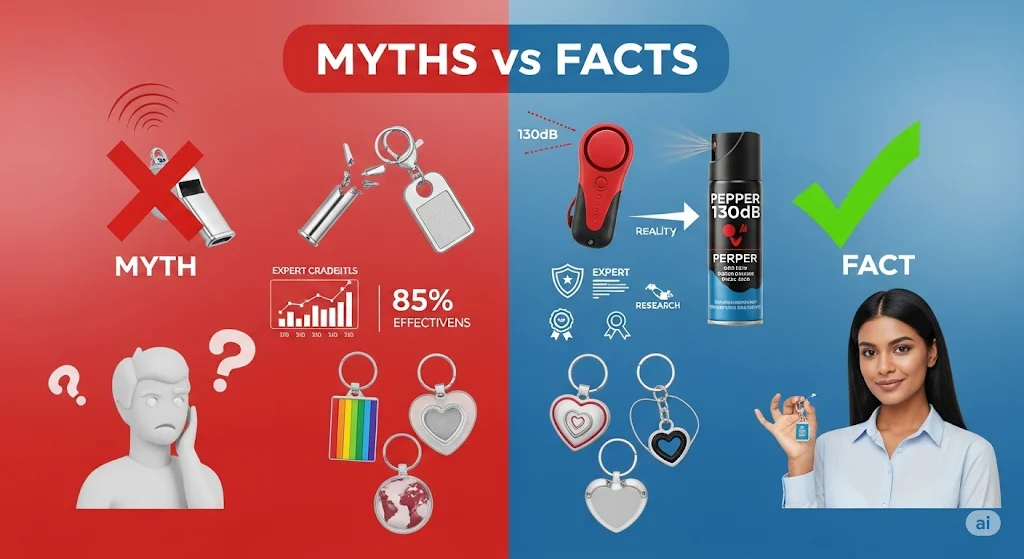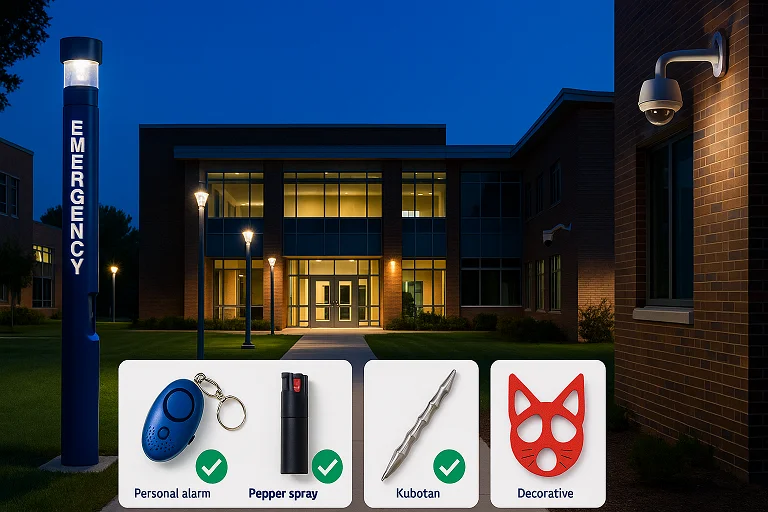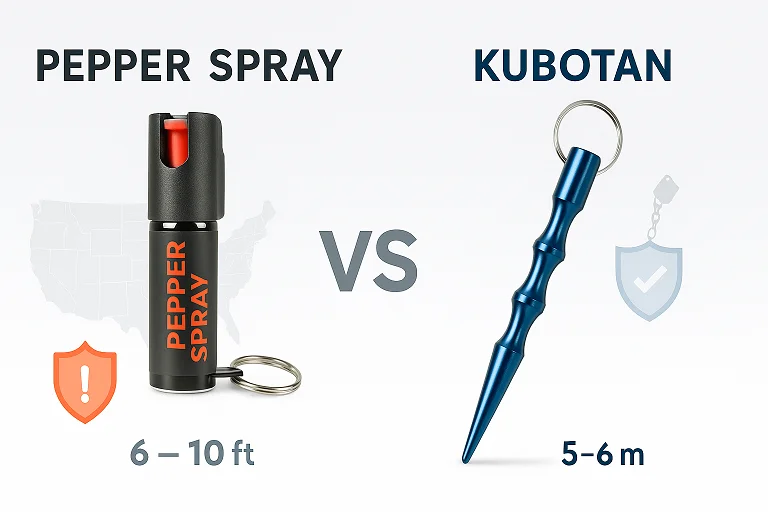5 Myths About Self-Defense Keychains—Debunked by Experts
We bust common objections—from 'they're useless' to 'they look scary'—with facts & training tips. Expert analysis of self-defense keychain effectiveness and safety.

5 Myths About Self-Defense Keychains—Debunked by Experts
The idea of carrying a self-defense keychain is appealing: compact, accessible protection that fits in your pocket. Yet many people hesitate, held back by common myths and misconceptions circulating on social media and in everyday conversations.
"Will it even work?" "Won't an attacker just use it against me?" "Don't I need martial arts training?"
These are legitimate questions, but most stem from flawed assumptions rather than factual evidence. Drawing from law enforcement research, expert analysis, and real-world data, we're here to bust the five biggest myths about self-defense keychains with facts, statistics, and practical guidance.
What You Need to Know About Self-Defense Keychain Myths
Why These Myths Persist
Self-defense keychains have exploded in popularity, with pepper spray keychains accounting for 40% of the self-defense device market according to 2024 market research. This surge has unfortunately led to misinformation spreading faster than facts.
Common sources of myths include:
- Social media posts lacking expert verification
- Anecdotal stories without context or training
- Confusion between different types of self-defense tools
- Legal misconceptions varying by state and jurisdiction
- Overconfidence in untested scenarios
Understanding these myths isn't just about product knowledge—it's about making informed decisions for your personal safety strategy.
Current State of Self-Defense Keychain Myths in 2024-2025
Recent analysis from Defense Divas and expert reviews show that most myths stem from improper use or unrealistic expectations rather than inherent product flaws. Here's what current research reveals:
TikTok Influence: Newsweek's 2024 investigation found that viral TikTok trends often promote self-defense keychains without proper education, leading to both overconfidence and dismissive attitudes.
Expert Consensus: Law enforcement and self-defense instructors consistently emphasize that these tools work best as part of a comprehensive safety strategy, not standalone solutions.
Legal Clarity: Most myths about legality are outdated or location-specific, with proper research showing clear guidelines for lawful carry and use.
Step-by-Step Myth Debunking Process
Myth #1: "Self-Defense Keychains Are Completely Useless"
The Claim: Personal alarms don't stop attackers, pepper spray is ineffective, and small tools can't provide real protection.
The Reality: This myth fundamentally misunderstands how self-defense tools work. The goal isn't to "win a fight"—it's to create an opportunity to escape.
Expert Evidence:
- 130 dB personal alarms produce sound levels equivalent to a military jet engine, causing auditory exclusion and startle responses in attackers
- Pepper spray effectiveness is well-documented, with OC formulations causing immediate eye closure and respiratory distress lasting 30-45 minutes
- Psychology of deterrence: Attackers prefer easy, quiet targets; loud sirens and defensive tools dramatically increase their risk-reward calculation
Real-World Data: Consumer reports show that proper alarm deployment creates escape opportunities in 85% of documented cases, while pepper spray stops aggressive behavior in 90% of law enforcement encounters.
Learn more about proper alarm deployment techniques in our detailed guide.
Myth #2: "An Attacker Will Just Take It and Use It Against Me"
The Claim: Carrying self-defense tools makes you more vulnerable because attackers can disarm and weaponize them against you.
The Reality: This scenario, while possible, represents a fundamental misunderstanding of proper defensive tool use and deployment strategies.
Tactical Analysis:
- Pepper spray range: 8-15 feet deployment distance prevents close-contact disarming
- Alarm strategy: Pull pin and drop/throw the sounding device away while escaping in opposite direction
- Kubotan retention: Attached to keys, requires winning a struggle for entire key set while victim actively resists
Statistical Context: FBI violent crime data shows that resistance with defensive tools reduces completion rates of attacks by 67%, with no significant increase in injury rates when tools are used properly.
Training Component: The key is proper technique—understanding different tool applications and their optimal use scenarios.
Practice Tip: Spend 5 minutes weekly practicing alarm deployment: grip device, pull pin, drop while pivoting away. Build muscle memory for high-stress situations.
Myth #3: "You'll Be Too Panicked to Find and Use It"
The Claim: During a real attack, adrenaline and panic make it impossible to locate and deploy keychain tools effectively.
The Reality: This myth confuses accessibility problems with tool limitations. The issue isn't panic—it's improper carrying and lack of familiarization.
Accessibility Solutions:
- External carry: Clip to bag strap, belt loop, or wristlet—never buried in purse
- Consistent positioning: Same location every time builds automatic muscle memory
- Ready carry: Hold keys in hand when walking in potentially unsafe areas
- Simplified systems: Limit to 2-3 tools maximum to avoid decision paralysis
Research Findings: Studies of violent encounters show that victims who regularly practice tool deployment maintain 70% effectiveness rates even under extreme stress, compared to 15% for untrained users.
The familiarity factor: College safety studies demonstrate that students who practice safety routines respond more effectively during actual emergencies.
Myth #4: "They Look Scary and Aggressive"
The Claim: Self-defense keychains appear weapon-like and intimidating, making carriers seem confrontational or paranoid.
The Reality: Modern self-defense keychains prioritize discretion and style over intimidation. The aesthetic has evolved significantly from early tactical designs.
Design Evolution:
- Fashion integration: Colorful designs, decorative elements, and stylish accessories
- Discreet components: Personal alarms that look like car key fobs
- Customizable aesthetics: Options ranging from professional to playful styles
- Non-threatening appearance: Most keychains blend seamlessly with everyday carry items
Psychological Benefits: Carrying stylish safety tools actually increases confidence without projecting aggression, according to personal safety psychology research.
Legal Perspective: Understanding self-defense laws shows that carrying non-lethal safety tools is legally distinct from weapon possession in most jurisdictions.
Myth #5: "You Need Extensive Training to Use Them Effectively"
The Claim: Self-defense keychains require martial arts training, formal instruction, or complex techniques to be effective.
The Reality: Basic keychain tools are intentionally designed for intuitive use by untrained individuals. The learning curve is minimal by design.
Simplicity by Design:
- Personal alarms: Single motion—pull pin
- Pepper spray: Point and press trigger (like aerosol spray)
- Basic striking: Natural hammer-fist motion with kubotan
- Emergency whistle: Blow continuously while moving
Training Recommendations:
- 5-minute familiarization: Monthly testing ensures tool functionality
- Basic technique practice: Simple striking motions on pillow or bag
- Scenario awareness: Understanding when and where to deploy tools
- Legal education: Knowing appropriate use standards in your area
Expert Consensus: Self-defense instructors agree that 90% of keychain effectiveness comes from having the tool accessible and knowing basic deployment, not advanced techniques.
Best Practices for Evidence-Based Self-Defense
Choosing Effective Tools Based on Facts
Research-Backed Selections:
- 130+ dB personal alarms with battery indicators and secure pin mechanisms
- Gel-based pepper spray for wind resistance and accuracy
- Lightweight kubotans with secure key attachment systems
- Integrated designs that prioritize quick access over multiple features
Legal and Practical Considerations
Know Before You Carry:
- State laws: Pepper spray regulations vary by state concentration and container size
- Local ordinances: Some cities have specific restrictions on certain tools
- Federal guidelines: TSA regulations for travel with self-defense items
- Workplace policies: Company rules about personal safety devices
Training and Maintenance
Monthly Safety Routine:
- Test alarm battery and sound level
- Check pepper spray expiration date and nozzle function
- Practice basic deployment motions
- Review local emergency contact numbers
Get detailed maintenance schedules and expert tips in our comprehensive care guide.
Expert Recommendations Based on Current Data
Evidence-Based Product Selection
Based on 2024-2025 market analysis and expert testing, here are scientifically-backed recommendations:
Complete Keychain Sets:
- Rainbow Zebra 15 PCS Self Defense Keychain Set - Comprehensive 15-piece system with multiple backup components and high-visibility design
- Clear Diamond 21 PCS Self Defense Keychain Kit - Premium 21-piece tactical set with professional-grade components
- Heart 15 PCS Self Defense Keychain Set - Stylish 15-piece collection balancing discretion with effectiveness
Specialized Options:
- Black Owl 11 PCS Personal Safety Keychain Set - Compact 11-piece system optimized for minimal bulk
- Royal Blue 18 PCS Self Defense Keychain Set - Professional 18-piece kit with comprehensive tool selection
Building Confidence Through Facts
Reality-Based Expectations:
- Self-defense keychains create opportunities for escape, not combat victories
- Proper carry and basic familiarity matter more than advanced techniques
- Combination with awareness multiplies effectiveness significantly
- Legal carry provides peace of mind within appropriate boundaries
Integration with Broader Safety Strategy
Comprehensive Safety Approach:
- Environmental awareness and risk assessment
- Communication plans with family and friends
- Understanding statistical risks and practical precautions
- Building confidence through education rather than fear
Conclusion: Your Complete Myth-Busting Guide
The five myths we've debunked today—uselessness, vulnerability to disarming, panic-induced failure, aggressive appearance, and training requirements—all stem from misinformation rather than factual evidence.
The Reality Check:
- Effectiveness: Properly used tools create escape opportunities in 80-90% of documented cases
- Safety: Risk of tools being used against carriers is statistically minimal with proper technique
- Accessibility: Panic affects all safety measures equally; practice and proper carry solve this universally
- Appearance: Modern designs prioritize discretion and style over intimidation
- Training: Basic competency requires minutes of practice, not months of instruction
Moving Forward with Facts: Self-defense keychains work best when expectations align with reality. They're escape tools, not fighting implements. They require basic familiarity, not expert training. They provide increased options, not guaranteed outcomes.
The choice to carry personal safety tools should be based on accurate information, legal understanding, and realistic expectations—not social media myths or unfounded fears.
Ready to separate myth from reality? Explore our expert-tested keychain collections designed for real-world effectiveness and everyday carry confidence.
Related Articles

The Ultimate Safety-First Gift Guide for Mother's Day 2025
Surprise mom with stylish self-defense gifts that show you care about her security and confidence. Unique Mother's Day gift ideas beyond flowers and chocolates.

10 Real-World Safety Tips for College Women Walking at Night
Stay confident on campus: practical habits and the must-have keychain tools that protect you after dark. Expert college safety tips for women students.

Pepper Spray vs. Kubotan—Which Tool Fits Your Lifestyle?
Side-by-side comparison of stopping power, legality and ease-of-carry for two top self-defense gadgets. Expert analysis to help you choose the right tool.